Chinese Characters That Look The Same 😲 Our Guide to The Characters You Have To Get Right

There’s a lot of Chinese characters in total!
How many Chinese characters? Too many!
Due to this, there are a number of Chinese characters that look very, very similar. Hardly surprising given the huge numbers!
Therefore, we’ve decided to give you a helping hand.
This blog is aimed at ironing out all those little mistakes you are making, from the very basics, to the more advanced learner!
We’ve also got a little extra at the end also. Traditional Chinese characters that look the same as well as Joker entries. Find out more below…
Similar Chinese Characters || Simplified
Similar Chinese Characters || Traditional
Similar Chinese Characters || Joker Entries
BONUS FREEBIE – Similar Chinese Characters Quiz
Similar Chinese Characters || FAQs
Similar Chinese Characters – Simplified Chinese
我 / 找 – Wǒ / Zhǎo

Probably one of the more important ones to iron out given the fact the first character is the Chinese character for I!
The key here is to look for the stroke on the top left of 我, which does not exist on 找.
TIP – Also take care with the characters for money and line 钱 线. These follow a similar pattern in the sense they both look the same on the right hand side but have a different radical on the left.
- 我是英国人 – I am from the UK.
- 我找不到你 – I cannot find you
- 我没有钱 – I don’t have any money
- 二号线 – Line 2
已 / 己 – Yǐ / Jǐ

Struggling to see the difference?
These two are almost identical but for a tiny flick on the Yǐ 已.
- 我已经知道 – I already know
- 相信你自己 – Believe in yourself
TIP – 已 on it’s own means to stop, cease or end whereas 己 means oneself or personal.
A smart way to differentiate these is the 已 (which begins with the letter Y in pinyin), looks more like a y because it has the little flick on that the 己 doesn’t have.
Very careful eye to detail when learning Chinese, but once you know, it’s a piece of cake!
末 / 未 – Mò / Wèi

We’d say this is one that stumps people the most, no matter what your level.
Even some of our most advanced students get these mixed and you can see why.
The only difference lies in the horizontal strokes. Wèi has a slightly shorter top. Mò has a slightly shorter 2nd stroke.
Confusing right!
- 未来 – Wèi lái (coming up, approaching, next, future)
- 周末 – Zhōu Mò (weekend)
These, as you’ll notice, are two fairly common characters and can actually both be used in the same context so be very careful with them.
我本周末要回英国 – I’m going back to the UK this weekend.
她有一个光明的未来 – She has a bright future.
How to remember them? Have your own methods I guess, this is just one of those you might have to drill in multiple times.
OUR METHOD – We, as lovers of the weekend, often say the weekend is TOO SHORT. So why not use this but change too to two (still with us…?)! Two Short, meaning the 2nd stroke is shorter.
人 / 入- Rén/ Rù
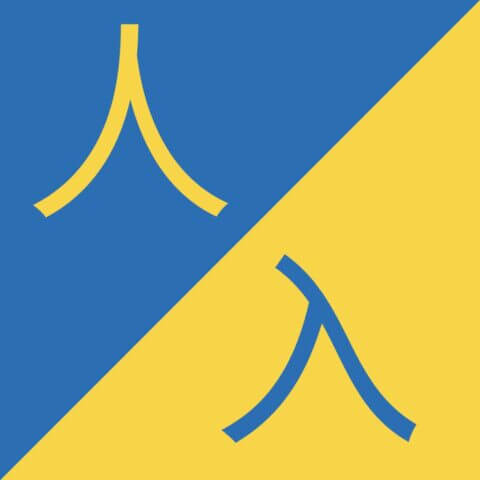
Almost identical but not quite…
- 中国有很多人。 – China has many people
- 他倒车入车库。 – He backed his car into the garage.
TIP – 人 as we all know, means person or people whereas 入 means to enter, to go into, to join.
A smart way to differentiate these two characters is to think about the character 人 as two people leaning on each other with their backs, and 入, on the other hand (if you think really hard) looks like an entrance, since the second stroke is longer than the first one.
人 also gives the impression of a person walking, fully upright. Whatever works best for you!
土 / 士 – Tǔ / Shì
This can be a particularly tricky one to define. The key is defined on the final stroke at the bottom.

- 蚯蚓生活在土中。- The earthworm lives in the soil.
- 博士 – doctor; Ph.D.
TIP – 土 on its own means earth, dust, local and 士 means scholar or soldier/warrior; it also appears in many official titles, such as “Ms., lady” (女士, nǚ shì).
These two characters look frustratingly similar, but we believe that a smart way to differentiate them is to connect 土, and its longer final stroke with the meaning “earth”.
The character 士 is used in a lot of official names and titles, such as 士兵 (soldier), 人士 (public figure), 战士 (fighter; soldier), 士人 (scholar).
So just remember the longer stroke, relates to the Earth!
TIP – Another way you could remember this is that the 3rd tone generally has a longer sound than the 4th tone which is more abrupt and fast. Therefore 土 has a longer stroke at the bottom because of the longer sound.
环 / 坏 – Huán / Huài

They sound similar and they look similar, just makes our job even harder.
What’s more, the reason I came across this example was during some studying on the Metro.
I’ve been fully aware of these characters for a while – they are both fairly common, but sat next to each other in a sentence, and you are left bamboozled, or at least I was!
So the difference is minor but we can tell easy enough from the image, just one stroke on the top left of 环 Huán is the difference here.
Now as already stated these are pretty common characters so it’s best to make sure you are aware of these difference early on!
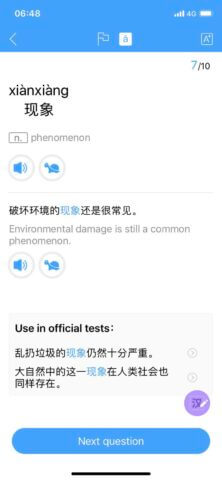
- 环 – Ring, hoop, link
- 坏 – Bad, harmful
…and some useful words that you may come across are:
- 坏蛋 (actually a swear word) – this means bad egg, scoundrel or b@stard
- 坏处 – Disadvantage
- 坏脾气 – Bad temper
- 环境 – Environment
- 换成 – Around the City
Actually the reason I came across this example as stated above was through studying Chinese on my phone.
You’ll see with the screenshot where the confusion came from.
Normally I’d have no problem telling these two apart, but when placed together, in a relatively complex sentence, I was left stumped!
So in a lot of these examples the saving grace is that you’ll rarely see them together in context. This is an exception!
干 / 千 – Gàn / Qiān
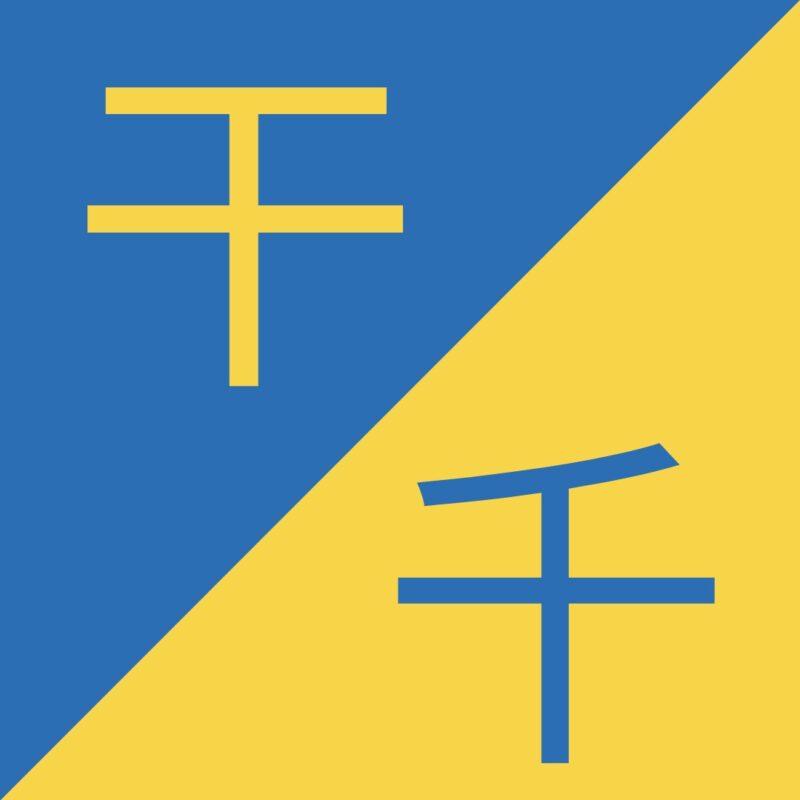
Another head scratcher!
TIP – This is a very good example of when stroke order really, really matters!
These two characters are seemingly similar, but when you look at them closer, you will see that the first stroke in 千 is sloping down and left, and 干 has a horizontal, left-right stroke.
千 is a fairly common character which appears in numbers, since it means “thousand”.
干 on the other hand is a bit more complicated, since it is a result of simplification of several traditional characters (four, to be exact).
This is the reason 干 has several meanings (and even different pronunciations!), such as “dry”, “clean” or “ignore”.

Basic Mandarin 📣 105 Simple Phrases To Make Your Life Easier
Basic Mandarin Phrases – Learn the Chinese greetings and other basic phrases in minutes with our pocket guide for Chinese beginners,
江 / 汪 – Jiāng / Wāng

With this pair, it’s not too difficult to spot the difference when you see them side by side.
The character 汪 has an extra line in the middle. It’s made up from 王 meaning ‘king’ with the 3 dots of water radical, whereas 江 is made up of the character 工 with the water radical.
However, the difficulty lies in the fact that both character can be used as surnames. 江 is quite a bit more common than 汪, so be careful if you see it to read it as Wāng and not Jiāng.
On their own:
- 江 Jiāng means river. For example: 长江 the Yangtze River (lit. ‘Long River’).
- 汪 Wāng can mean pond/pool
特 / 持 – Tè / Chí (寺 sì)

Little more complex these two, which makes confusing them much easier than others!
- 特 – Special, Unique
- 持 – Hold, Grasp, Support
And the 3rd example in brackets as a bonus
- 寺 – Temple
You’ll actually see the 3rd one all over China for obvious reasons.
Likewise the 1st character 特 in a number of common words such as:
- 特别 – Special/Particular
- 特产 – Special Local Product (another for the tourist trail)
- 特点 – Characteristic
The difference lies in the radical on the left side of the characters. 持 uses the radical for hand, which would explain the meaning to hold or grasp.
TIP – Using radicals to pick apart similar characters is a great way to de-code their meanings.
辛 / 幸 – Xīn / Xìng

These are quite awkward to differentiate because of the fairly complex nature of them and number of strokes.
The bottom half of both characters is the same, the top has a slight difference.
- 辛 – Hot (adj)/Suffering (Noun)
- 幸 – Fortune/Good Luck/Happiness
幸 is a character you’ll see a lot especially during Chinese New Year due to its meaning. Words associated with positivity include:
- 幸福 – Happiness
- 幸运 – Good Fortune
- 幸亏 – Fortunately
Xìng is certainly more common than Xīn, just remember to look out for the top which is where the difference lies.

Chinese New Year Beijing ⭐️ Top Things to Do During the Festival 2024
Experience the Magic of Chinese New Year in Beijing: A Guide to Celebrating the 2024 Year of the Dragon Chinese New Year, also known as Spring Festival, is the most important holiday in China, marked by festive celebrations, family reunions,…
今 / 令 – Jīn / Lìng

Two common characters here that you’ll see in most levels from the earlier stages of your Chinese studies:
- 今 – Modern/Present
- 令 – Order/Command
One of those earlier words you’ll learn will be 今天 meaning today.
Throwing in a 3rd one here you’ll also probably notice this is equally similar
冷
This is another common character which means cold but the saving grace here is the water radical which gives it a key difference.
Back to the first two and the only difference is a final stroke on the end of Lìng which is very easy to miss.
Take care!
牛 / 午 – Niú / Wǔ

Two characters you’ll see everywhere so be careful!
- 牛 – Cow
- 午 – Noon
Not just these words but these two characters are represented in many other common words such as:
- 牛奶 – Milk
- 下午 – Afternoon
- 牛肉 – Beef
- 午饭 – Lunch
- 牛仔 – Cowboy
- 午夜 – Midnight
Some very widely used words there.
They key difference is the very top where 牛 has a slight extension. 午 cuts off where the two lines meet.
尘 / 尖 – Chén / Jiān

The difference seems clear enough with these (focus on the bottom half of the characters) but it’s still surprisingly easy to get these mixed up.
- 尘 – Dust/Dirt
- 尖 – Point (of a needle)/Tip/Top
Ironically both almost have opposite meanings with 尘 focusing on the dust or dirt (based on the ground) and 尖 pointing upwards to the top.
Some vocab including the characters:
- 尖刀 – Sharp Knife
- 尖峰 – Peak/Summit
- 尘土 – Dust
- 尘云 – Dust Cloud
乐 / 东 – Lè / Dōng

Two common characters here but the differences are clear enough to make this not such a complex example.
DISCLAIMER – One thing to note before is that 乐 is one of those confusing characters with two meanings which might add to the confusion. Hear us out…
乐 means to be happy, cheerful or laugh BUT take the word for music:
音乐 – Yīn yuè
See how the second character is pronounced yuè, despite the fact it is the same as Lè.
Be careful, some characters have this double meaning. 了 and 行 are two examples but that conversation is for another day!
Back on topic 东 means East so this is a character you will come across a lot also.
The key difference as you’ll probably have noticed lies across the top where 东 has a perfectly horizontal stroke that is dissected. 乐 is slightly curved with no dissection.
刀 / 力 – Dāo / Lì

Two of the simpler characters you’ll get to know when learning Chinese.
- 刀 – Knife
- 力 – Power, Force, Strength
The tiny vertical flick being the only difference here.
Although clear, they are still similar enough to mix up quite easily especially when reading.
There are many useful words to learn with these characters, not least using 力:
- 力 气 – Physical Strength
- 努力 – Hard Working
- 压力 – Pressure
- 动力 – Motivation
- 刀叉 – Knife and Fork
手 / 毛 – Shǒu / Máo

We have to confess… this was one that some of our staff members were getting confused with for quite a while.
Again, when the two characters are side by side, it’s not too tricky to see the difference; the strokes are different!
手 flicks to the left, and 毛 flicks to the right.
But when you see one of these on their own, especially when you first start learning Chinese it’s quite a common mistake to get them mixed up.
Here’s what they mean:
- 手 Shǒu means hand. For example mobile phone in Chinese is 手机 shǒujī (literally ‘hand device’).
- 毛 Máo means hair, fur or wool. For example 毛衣 máoyī means woollen jumper or sweater.
- 毛 Máo can also be a Chinese surname – like Chairman Mao!
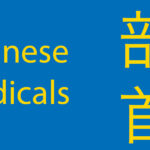
Chinese Radicals | Unlock Their Potential and Crack The Code (FREE PDF, Poster AND Quiz Included)
Chinese Radicals | An Introduction to Understanding Them (PLUS Free Quiz, Video & PDF) What are Chinese Radicals and how do we use them? Preview of our FREE Radicals PDF Download This is your complete guide to understanding how they…
大 / 犬 – Dà / Quǎn
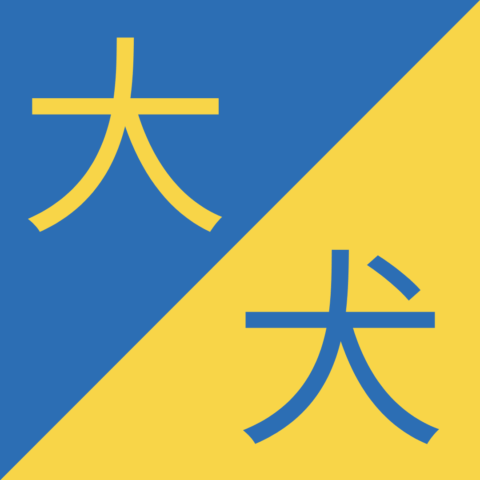
Very similar but thankfully the second character is only used in written Chinese and is the more formal version of a more popular character:
- 大 – Big
- 犬 – Dog (written Chinese)
DID YOU KNOW – the character for Dog in Chinese (written) is the same as the character for Dog in Japanese! Just a different pronunciation – 犬 (Inu).
大 is incredibly common and is used in many texts, articles etc. It’s also quite an easy one to remember as it appears to resemble a large stick man to represent its meaning, big.
犬 is a character you won’t see much so there is no real worry here about mixing them up.
The more popular and spoken form of 犬 is 狗.
So if you wanted to say big dog you wouldn’t say 大犬, but 大狗.
Oh and just to confuse matters with a third character thrown into the mix – 太.
Now this is a common character and means too as in “too much” or “too tired”. Oh boy!
- 太大了 – Too big
- 太累了 – Too tired
- 太贵了 – Too expensive
谁 / 准 – Shéi / Zhǔn (推 Tuī)

The key here is the left hand radical. Even then, actually they still look remarkably similar so take care with these.
They could well appear in the same sentence also given the meanings and frequent nature they pop-up in day to day life:
- 谁 – Who
- 准 – Allow/To Grant
Clearly the word for “who” is one you’ll use a lot. 准 likewise has many other characters which, when paired, have further meanings. Common examples that are useful to learn are:
- 准备 – Prepare
- 准确 – Accurate/Exact
- 准时 – Punctual/On Time
To further add to the melee, a 3rd character here also falls into the same bracket:
推 Tuī
This means to push and you’ll therefore be faced with this on pretty much every public door you stumble across.
TIP – The key to remembering this third one is in the radical again (as is so often the case). See the right hand side? The hand radical is shown. We use our hands to push.
耍 / 要 – Shuǎ / Yào

Intriguing example this one because it features one of the most common Chinese characters you’ll find, and another that you won’t stumble across until more advanced stages of learning.
Nonetheless, these have a very similar appearance and can appear in the same context – almost a given considering the fact 要 appears in most sentences!
- 耍 – Play with/trick
- 要 – Want/Will/Must
The latter will appear in some of the first sentences you learn for example:
I need to buy a new phone – 我需要买一部新手机
You’ll notice the difference between the two is subtle, but clear enough with the lack of one stroke in 耍 on the top half of the character.
市 / 布 – Shì / Bù
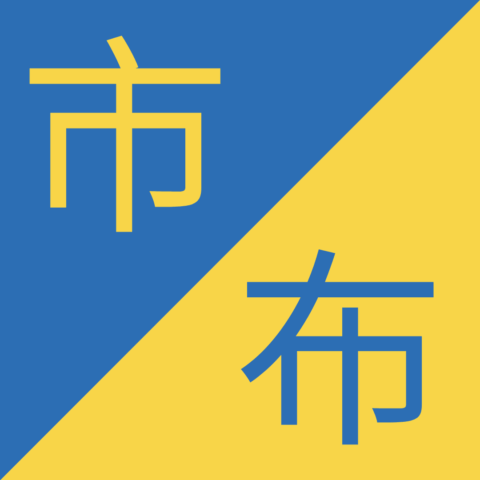
These two are particularly troublesome, any kind of cursive text or handwriting can make it really difficult to differentiate the them.
Though if you look at the top parts of 布 and 市 you can see they use different strokes
Thankfully their meanings are quite different, so context alone should also help you tell them apart:
- 市 Shì can mean city like in 城市 (chéngshì) , but it can also mean market for example: 市场 (shìcháng).
- 布 Bù on its own means cloth, like in dishcloth 洗碗布 (xǐwǎn bù). It can also be a verb meaning to declare or announce, such as in the word 发布 (fābù) meaning issue or release.
实 / 卖 / 买 – Shí / Mài / Mǎi

Now this is a very interesting example which is so commonly mistaken.
In Chinese “buy and sell” translates to:
买和卖 Mǎi hé mài
Now, although it makes it easy to remember that Buy and Sell have the same pinyin (but different tone), when reading this becomes a whole new challenge.
Throw in the 3rd character and you are left scratching your head!
- 实 – Reality/Fact
- 卖 – Sell
- 买 – Buy
Reality and to buy are incredibly similar. The key with all three is to keep your eye on the top of the character.
TIP – Sell has a distinctive 十 sign at the top of it. You can remember this by thinking “sell something and you get ten dollars/pounds etc” Remember in Chinese 十 means ten.
To then figure out how to define between 实 and 买 is another challenge!
师 / 帅 – Shī / Shuài

With these two characters there’s just one line that makes them different.
You can see that 师 has and extra stroke at the top, compared with 帅.
This small difference can make it difficult to tell these two characters apart.
- 师 Shī – means teacher and is used in the word 老师 which is a common word for teacher.
- Another frequently used word with this characters is 师傅 which literally means ‘master’, is a respectful way to refer to men, for example your taxi driver.
- 帅 Shuài – means handsome or beautiful. It’s generally used to describe men.
- 帅哥 literally means ‘handsome brother’, and it’s used frequently to address men.
农 / 衣 – Nóng / Yī

Luckily context should help you differentiate these two characters, although they do look very similar.
The top half of the two characters 农 and 衣 uses different strokes, whereas the bottom half of the characters are identical.
Here are their various meanings:
- 农 Nóng – on it’s own this means agriculture or farming. It’s put together with other characters to mean pretty much everything to do with these terms.
- 农民 means peasant; it’s a common way of referring to someone from rural parts of China.
- 衣 Yī – means clothing or garment. It’s generally put together with other characters to make words.
- 衣服 for example is a generic word for clothes, and 内衣 means underwear (literally ‘inside clothes’).
旱 / 早 – Hàn / Zǎo

Just one horizontal stroke is the difference between these two.
Here we have another example where one character is really quite common and the other a more advanced one so this shouldn’t cause issues with the beginner/intermediate learner, but when getting onto more detailed texts like newspapers and novels, you might have to double take!
- 旱 – Drought
- 早 – Early
As you can imagine drought isn’t a word you’ll need an awful lot day-to-day but early is certainly a useful word to have in your bank.
You’ll notice another small difference between the two apart from the extra stroke. Seen it yet?
Note how 早 is actually attached to the top half of the character but 旱 is completely detached. Another way to help differentiate these.
见 / 贝 – Jiàn / Bèi
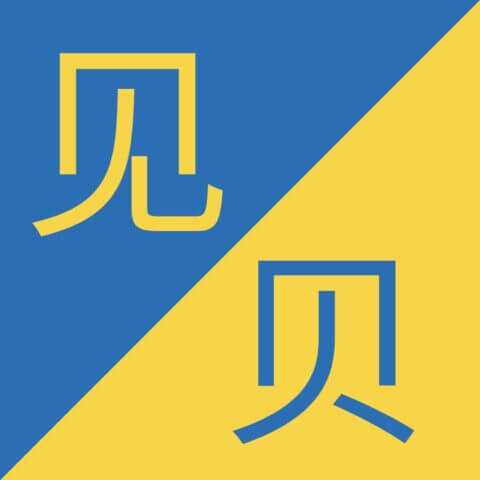
Taking just a quick glance at these two characters, it’s really easy to see how you might mix them up.
The top part of 见 and 贝 are the same, but you might be able to see that the stroke to the bottom right part of each character is different.
Let’s look at what they mean, and how they’re used:
- 见 Jiàn – to see or to meet
- For example 见到 means to see or catch sight of something, and 见面 means to meet somebody.
- 贝 Bèi – this refers to a sea shell or in some cases to money.
- It’s often used in words translated from other languages to make the sound ‘bèi’, for example bass guitar is 贝斯 bèisī
In ancient times shells were used as currency in China, that’s why the character 贝 Bèi is often used as a radical in words that refer to money or financial matters. For example 财富 cáifù means ‘wealth’ or ‘riches’, and 财政 cáizhèng means ‘public finance’.
便 / 使 – Biàn / Shǐ

Be careful with these because one of them has a rather distasteful meaning.
便 – has multiple meanings (as most characters do) but one of the main meanings is urine/excrement. Don’t want to be getting this one mixed up do you?!
That said 便 also means convenient/suitable and appears in common words such as:
- 便利店 – Convenience Store
- 便于 – Easy to
Our second character is 使 and means to make/enable or use.
The sole difference is the former include an extra stroke which you can spot from the images on the right.

How to Use a Chinese Keyboard // A Super Simple Guide
How to use Chinese Keyboard? Typing in Chinese, it can be a daunting concept having to then type in Chinese characters and use a Chinese keyboard.
水 / 永 – Shuǐ / Yǒng

Not the most similar out of all the examples here but still very much worth bringing to your attention.
Two little differences to note:
- 永 has a little stroke at the very top, 水 does not
- 永 also has a flick at the top, on the vertical character, 水 remains straight
- 水 – Water
- 永 – Eternal, long lasting
Of course with the 1st character being water, it’s one you’ll see everywhere whereas the 2nd is isn’t SO common, although still one you’ll see out and about.
夫 / 天 – Fū / Tiān

These two look quite similar, with only a small difference in the placement of the top line!
But beware: If you mix them up, you’ll end up with some very amusing mistakes!
- 夫 – Husband
- 天 – Day
So if you say want to write ‘today,’ be careful to say 今天 jīn tiān instead of 今夫 jīn fū (which is not only not a word, but also comes across as current husband based on the hanzi)!
友 / 反 – Yǒu / Fǎn

These two are also fairly easy to mix up, with the same radical 又 yǒu under their two upper lines. Additionally, the main difference is that 友 crosses its upper lines whereas 反 does not.
- 友 – Friend
- 反 – Reverse
Even their meanings are contradictory, so pay close attention to these two!
咸 / 或 – Xián / Huò

There are two main differences between 咸 and 或:
- 咸 has the long left line descending from the upper horizontal stroke.
- 或 has the small line under the 口 (in the middle of the hanzi) rather than on top of it.
- 咸 – Salty
- 或 – Maybe
The good news is that you’ll see 或 far more often than 咸, as 或者 huò zhě (maybe) is more commonly used in everyday Chinese, whereas 咸 is only used with food.
Similar Chinese Characters – Traditional Chinese
Most learners of Chinese stick with the simplified version (the reason being in the name!).
That said there are still plenty of lovers of Traditional Chinese. In fact, we teach Traditional Chinese at our Taiwan school so we absolutely cannot ignore these.
Of course, there are a lot of examples as many of the characters are far more complex (you don’t think)!
We’ll touch on a few examples which our very own students have said they struggle with from time to time, and also give you the simplified versions because we re nice like that!
職 / 識 – Zhí / Shí
SIMPLIFIED VERSIONS – 职 / 识

No fear, if those traditional characters give you a 头疼 (headache), you’ll be glad to know the simplified versions are much more friendly, and actually not as similar!
For the traditional lovers, this gets the cogs in the brain ticking!
Split the character into three parts – left, middle and right.
You’ll see middle and right are identical and just the left is different.
Even then, both include a number of horizontal strokes which just adds to the confusion. Upon looking deep enough we can see the difference with no issue, but upon first glance, and when reading, it’s not so easy!
The meanings of both are:
- 職 – Job/Duty
- 識 – Knowledge
Annoyingly they could very well be found in the same context too given the meanings! Ouch!
辦 / 辯 – Bàn / Biàn
SIMPLIFIED VERSIONS – 办 / 辩

Same sort of method applies here. Break the character down into three parts, left, middle and right.
Where does the difference lie this time?
It’s subtle but it’s in the middle.
- 辦 – Do/Handle/Manage/Tackle
- 辯 – Argue
This is, again, a set of two where you can clearly see the difference. The problem may well in lie when skim reading per-say.
What you will notice with some “simplified” alternatives is that they haven’t even been simplified at all, at least to our eye.
These two are a great example. 办 has clearly been simplified to far less strokes, 辩 not so much! Still looks quite complex doesn’t it!
DID YOU KNOW – In fact in one instance the simplified version of the traditional character is just a horizontal flip! Madness
That example is this:
夠 and 够
The left is traditional the right is simplified! Work that out!
邁 / 遇 – Mài / Yù
SIMPLIFIED VERSIONS – 迈 / 遇

Thankfully not the most complex of examples when it comes to number of strokes but still, quite a head scratcher given the fact that, on first glance these two look exactly the same.
As you’ll probably see, just a small radical on the top of Mài 邁 proves to be the difference here.
- 邁 – Step/Stride
- 遇 – Chance/Opportunity
You’ll notice that the simplified versions are very different with 邁 becoming 迈. The second character remains the same in simplified and traditional.
The difference, when you know it, isn’t too taxing.
The issue here is more reading at a fair pace or perhaps reading in certain fonts, where this becomes problematic.
變 / 戀 – Biàn / Liàn
SIMPLIFIED VERSIONS – 变 / 恋

Stroke after stroke after stroke. This is a crazy example but thankfully the radical at the bottom saves us!
- 變 – become different
- 戀 – love/attached to
The top strokes are plentiful but thankfully to differentiate between these two you don’t need to focus on that part, but just the bottom radical.
A good way to do this is look at 戀 – the radical represents the heart.
You love with your heart meaning this relates to love/attachment to something.
Tired out yet? We are!
But there’s one more element we want to cover quickly!
BONUS: Similar Chinese Characters – Joker Entries
What are joker entries then?
This is a small list of other very similar Chinese characters, but that you will never necessarily see together due to the fact one of them is incredibly rare, or never used.
That said, they are a point of interest so we wanted to cover a few for you!
七 / 匕 – Qī / Bǐ

This probably the main joker inclusion given that 匕 is a character you’ll near never see on its own so in theory there is no way you can mix these up.
That said, they still have a relatively similar appearance so we thought we’d throw it in here!
七 is very common and means the number 7 in Chinese.
Let’s take an example of another character here:
比 – one of the more common ways you’ll perhaps come across 匕 is using the character to compare (比) with 匕 featuring on the right hand side of the character.
Ironically enough the pinyin, and the tone for this word is exactly the same: Bǐ
So no worries on getting these mixed, but an intriguing example nonetheless.
暖 / 暧 – Nuǎn / Ài

The saving grace with these is that the 2nd character, ài, is very rarely used and in fact only features in one word – 暧昧 which means ambiguous.
Any other words would be incredibly rare and ones you’ll likely never to stumble across.
That said it’s probably one of the most difficult examples to wrap your head around because the difference between the characters is so subtle you can barely see it.
In handwritten Mandarin, or script, this would be even harder!
The change lies in two tiny downward strokes on the right side of ài.
- 暖 – Warm
- 暧 – Dim/Obscure
暖 is far more common than its brother so thankfully this won’t be an issue in most instances.
Ironically enough the two traditional versions are much easier to separate due to the fact they have more strokes. Odd that!
更 / 吏 – Gèng / Lì

See a similarity with the 便 / 使?
Don’t worry, just because you’ve gotten this far you aren’t barking mad seeing things. These characters are the same as the above, minus the left hand radical.
- 更 – More/Even More
- 吏 – Government Clerk/Official
As you’ll notice one of the character is very commonly used, the other not, simply given their meanings.
The difference is exactly the same as the above example, with the extra stroke in 更. It’s a hugely useful actually and can be used with other familiar characters to emphasize more of something:
- 更好 – Even Better
- 更多 – Even More
兵/乒/乓 – Bīng/Pīng/Pāng
Look at the three characters, look at them real close.
The difference is in only one stroke.
Yeah yeah, I know – this is one of those moments when you think “dear God, why am I studying Chinese?”.
But don’t worry, it’s easier than it seems. “乒乓” is only used in the word “ping pong” or “table tennis”. You just have to be careful not to write “乓乒”.
Just imagine that these two characters “乒乓 ” are a table and two parts of the table, that is the legs supporting the table. Simple, right?
“兵” on the other hand means “soldier, force, military, army, warforce”.
It is actually a very useful character and it is a part of many words
- “兵力” (bīnglì) for example means “military strenght”
- “士兵” (shìbīng) means “soldier”
- “兵器” (bīngqì) means “weapons, arms”
- “步兵” (bùbīng) is “infantry” (“步” means step, go on foot, so the literal meaning is “foot soldier”).
The reason this was a joker/bonus entry was because you often see the two together for the word “table-tennis” as mentioned above. A great example of visual ways to learn Chinese!

Motivation to Learn a Language 💪 A Guide to Staying Strong
Motivation to Learn a Language 🙌 The Tips You Need To Know Here’s some of the questions we hear a lot from students looking for motivation to learn a new language… How does motivation affect learning another language?How do you…
哀/衰/衷 – Āi/Shuāi/Zhōng
“哀” means “sorrow” or “grief”, “衰” means “to become weak” and “衷” means “inner feelings”.
So… “Sorrow”, “grief”, “inner feeling” and “become weak”. What does this tell us?
That all of these characters have something to do with feelings and emotions.
Now, I know that it can be confusing to see the difference in the characters, but you just need to focus at the line in the centre of the characters.
哀 doesn’t have a line/stroke, in the middle of the character that looks like “kou” (“mouth”), 衰 has a horizontal line and 衷 has a vertical line in the centre of the character that looks like “kou”.
Similar Chinese Characters || Quiz
As if you’re head isn’t hurting enough by now! It’s time to put you to the test, but don’t worry we’ve got your back!
Test out whether you can tell the difference between similar Chinese characters with our quiz.
Chinese Characters || FAQs
How long does it take to learn the Chinese Characters
Such a broad question and so tough to answer given that every situation is different.
That said, we believe if you come to China to learn Chinese, 4 hours a day (20 hours a week) and study for 18 weeks (a Semester), you can reach HSK3 level.
Double that to 36 weeks and you can reach HSK4 level which is just over 1,000 characters.
Do some Chinese Characters have more than one meaning?
Yes some Chinese characters have different meanings and pronunciations.
A couple of common examples are 得 – DE DĚI OR DÉ and 的 – DE, DÍ OR DÌ.
Are Chinese and Japanese characters the same?
There are some instances where the characters for Chinese and Japanese match but the languages are very different.
For a start Chinese doesn’t have an Alphabet, Japanese does (it has three actually, Hiragana, Katakana & Kanji).
What are the most common characters in Chinese?
You can find a list of the top 100 most common characters in Chinese here.
Want more from LTL?
If you wish to hear more from LTL Mandarin School why not join our mailing list?
We give plenty of handy information on learning Chinese, useful apps to learn the language and everything going on at our LTL schools.
Sign up below and become part of our ever-growing community.
BONUS | Learn Chinese with LTL in person. Our student community is growing by the week.


 Hi, my name is Ilaria! I am from Italy and I am a Student Advisor at LTL. Fancy coming to study with us in China? Drop me a message.
Hi, my name is Ilaria! I am from Italy and I am a Student Advisor at LTL. Fancy coming to study with us in China? Drop me a message.









15 comments
[…] Similar Chinese Characters – Check out our Blog Post […]
[…] Similar Chinese Characters – Check out our Blog Post […]
[…] Chinese, you come across an incredible amount of complex characters, or characters that look the same and it’s so easy to forget them or muddle them. Every Chinese learner can relate to […]
[…] you’re just starting to learn Chinese and get familiar with the characters, it can be a daunting concept having to then type in Chinese characters and use a Chinese […]
[…] if you know how to write it. Also, as your Chinese level improves you’ll find more and more similar characters with similar pronunciation but different meanings. If you don’t know the structure of a character and how to write it, it becomes really easy to […]
Thanks for helping out, I always get some of these mixed up. Will download and save to make sure I remember!
Thanks Paula - yes I think every single learner of Chinese has those characters they simply cannot get their heads around which is what inspired this post.
If you have others, we are happy to include, just let us know!
LTL
[…] Sheng carved individual characters on pieces of clay and then hardened them with […]
[…] ref: https://ltl-beijing.com/similar-chinese-characters/ […]
Supppperrrr cool list!
Thannnkkkks Tibo!
Some very interesting characters! Thank you for the post.
Thanks Jay! Appreciate the comment
I have learn some excellent stuff here.
Thank you 🙂